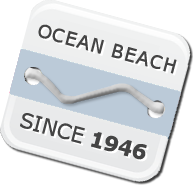THE HISTORY OF OCEAN BEACH NEW JERSEY
Ocean Beach has been a vacation destination for more than 75 years. Generations of families grew up coming here each summer for a week, maybe two, to play on the wide beaches and in the clean ocean. It is hard to imagine that at one time the area that now contains more than 2,000 cottages, was once covered with dunes and inhabited only by mosquitoes, shore birds and the occasional fisherman. All that changed when two enterprising young men decided to follow their dream…
It was 1946, and what was then a desolate, brush-filled tract of land just north of Lavallette was purchased by Fred Pearl and his partner, Edward Patnaude—two laundry deliverymen who, over the next 20 years, turned this tract and several others into a vacation paradise. Later, they named this paradise "Ocean Beach."
Their idea was to build beach houses for working-class families, those who could not afford to buy in affluent towns like Mantoloking and Bay Head. They began by building basic one- and two-bedroom cottages that cost $2,095 and were merely four walls and a roof with no paneling or insulation—even the hot water heater was optional.
The construction pace was fast and furious, with about one house going up every two days. Sales were transacted casually; Pearl worked out of what he called his “mobile” office — which was actually the trunk of his car. Each business day, he set up shop by pounding a wooden sign into the ground along the highway that read, “Houses for Sale.” At that time, all that was required to secure your own place in the sand was a $10 deposit and a handshake. The very first sale contract was signed on July 20, 1946, and still exists; it can be viewed in the pictures below.
It didn't take long for people to find and fall in love with Ocean Beach. The success of Unit I prompted the developers to buy another parcel of land in 1948, and a third, the largest at 75 acres, in 1951.
With the opening of the Garden State Parkway in 1955, sales and rentals went through the roof. To meet the demand, 1,000 houses were erected from the ocean front to the man-made lagoons along West Bayview Drive, and Unit III was born.
Despite being around for more than six decades, Ocean Beach has changed very little. You can still walk shoeless down the sand streets in Unit III, and watch the sunset from the Unit II clubhouse at the end of Harbor Drive.
Surprisingly, there still exists one cottage in its original state. It sits on Route 35 North between East Shore and East Surf, in the shadows of the many two-story homes that have popped up though out Unit I. The yellow siding, small windows and open porch are a quaint reminder of the old days.
FUN FACTS
- The Chadwick Penn Railroad station sat along what is now Route 35 South, at the western end of West Amberjack Way.
- Everyone knows that deed restrictions limit buildings in Ocean Beach II, III and the Shores to one story. But did you know there is also a restriction forbidding the harboring of horses, cows, pigs, goats, sheep, pigeons, ducks, geese and chickens?
- Goa Way, on the middle block in Unit III, was so named because the owner of a house that stood on the block refused to sell to the developers for years. Forced to lay a road around him, they named the street "Goa Way" -- because they wished he would! He finally sold, which is why West Tuna, Albacore, Osprey and Plover do not flow through to Route 35 South.
- Units I and II were developed from south to north, but Unit III started development at the Chadwick Beach border and progressed south. The larger lots on Albacore, Tuna and Osprey were a result in a change in Toms River Township's ordinance which prohibited building on lots the size of the original Unit III lots, which are 50x32.
- The Ocean Beach Marina showroom, on Route 35 South near Kittiwake Avenue, used to be a skating rink in Lakewood. In the early 1950s, it was actually cheaper to purchase the existing structure, disassemble and re-assemble it rather than build a structure with new materials.
- Originally, Route 35 North carried traffic going north and south. In 1960, the state paved over what had been a railroad track, creating Route 35 South.
- The first life saving (lifeguard) station in the country was once located at the top of Kittiwake Avenue in Seacrest Beach (between Ocean Beach II and III).
- A typical ocean block, two-bedroom cottage rented for $70 per week in 1953—$10 more if you wanted hot water. The rentals were basic then; there were no televisions, telephones or air conditioners in the units. Ocean fronts cost as little as $115 per prime week. What a difference 70 years makes: today, the most expensive ocean front rents for more then $6,000 per week in July and August, and, like many of our rentals, its amenities include central air, heat, washer, dryer, and dishwasher.
A TRIP DOWN MEMORY LANE
|

